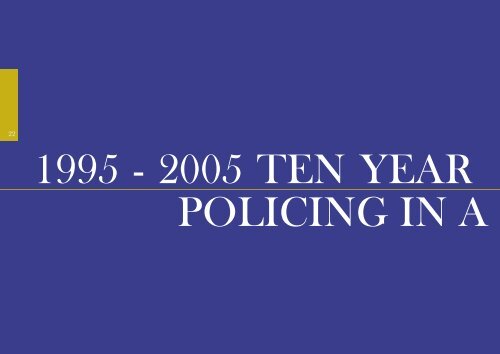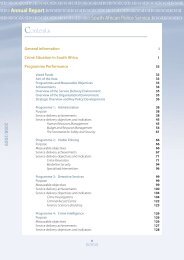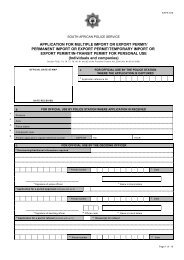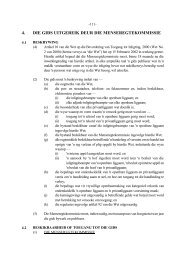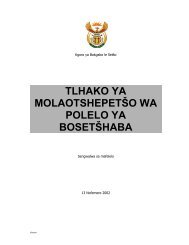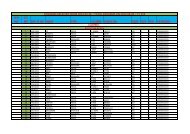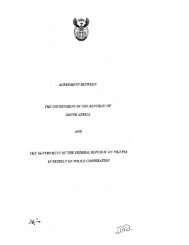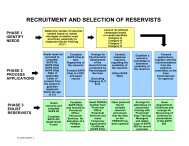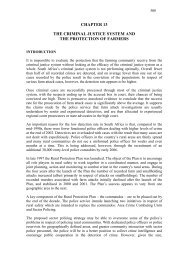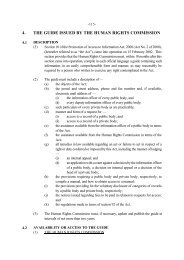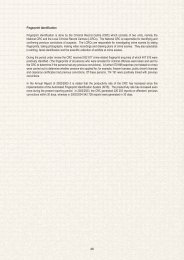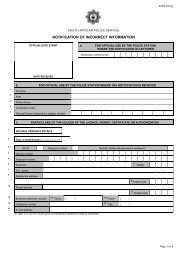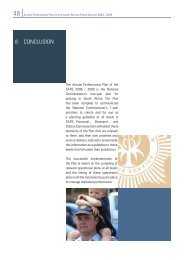Untitled - Saps
Untitled - Saps
Untitled - Saps
You also want an ePaper? Increase the reach of your titles
YUMPU automatically turns print PDFs into web optimized ePapers that Google loves.
22<br />
1995 - 2005 TEN YEAR<br />
POLICING IN A
23<br />
REVIEW OF<br />
DEMOCRACY
1994/1995<br />
10 Years of Policing in a Democracy 1995 – 2005<br />
24<br />
• The previous 11 police agencies (the SAP and 10 former homeland agencies) and Non-<br />
Statutory Forces entered a process of amalgamation and rationalization to create a single<br />
police service, the SAPS, which functions at national and provincial levels. Policing in<br />
South Africa was traditionally dominated by various laws that were undemocratic and<br />
that were rejected by the majority of people in the country. However, transformation<br />
by means of community policing that would see a shift from a police force to a police<br />
service was in progress to establish an active partnership between the police and the<br />
community.<br />
• Mr Sydney Mufamadi was appointed Minister for Safety and Security. Mr Joe Matthews<br />
was appointed Deputy Minister for Safety and Security. Mr Azhar Cachalia was<br />
appointed Director-General for the Secretariat for Safety and Security.<br />
• The managerial style of the new SAPS began a process of transformation, moving from<br />
an autocratic, bureaucratic and militaristic style of command to a managerial style<br />
characterized by participation and problem-solving. This transformation entailed respect<br />
for, and sensitivity towards, the fundamental rights of all members of the community<br />
- including all members of the new SAPS.<br />
• As part of the government’s war on crime, a seven-point plan was announced<br />
in 1995 to improve the effectiveness of policing. The plan involved redeploying<br />
resources - both human and material; improving visible policing; arresting most-wanted<br />
suspects; supplying police stations in all the flashpoint areas with the necessary logistics to<br />
increase their effectiveness; restructuring border-control functions; utilizing technology<br />
such as helicopter video units in flashpoint areas; and setting tougher bail conditions for<br />
serious crimes.<br />
• A new basic training project for SAPS members, geared toward producing constables<br />
equipped for community policing, was launched.<br />
• The SAPS divisions included the following:<br />
Division Community Relations: The division had a consultative function and liaised<br />
internally with fellow police divisions and externally with communities to find solutions<br />
to problems and to formulate policies, priorities and strategies. The division mobilized<br />
all resources available to a community to resolve problems of disorder and to promote<br />
safety and security.<br />
Division Crime Combating and Investigation: The division consisted of the following units<br />
and bureaus:<br />
- A National Bureau for Missing Persons (established in October 1994), which worked<br />
closely with Crime Stop, a programme launched in 1993. (The programme has<br />
recovered stolen property and narcotics worth more than R1 billion since 1994.)<br />
- The Commercial Crime Unit, formerly known as the Commercial Branch, had<br />
its headquarters in Johannesburg. There were several Commercial Crime units<br />
throughout South Africa.<br />
- The Forensic Science Laboratory, which consisted of the Analytical Chemistry,<br />
Biology, Ballistics, Disputed Documents and Electronics Units.<br />
- The Diamond and Gold Branch which was charged with combating illicit dealing<br />
in, and possession of rough or uncut diamonds, semiprecious stones, tiger’s-eye and<br />
unwrought precious metal such as gold, silver and platinum.<br />
- The South African Narcotics Bureau, which combated drug-related crime on an<br />
organized and specialized basis throughout the country.<br />
- The Murder and Robbery units, which were stationed in Pretoria, Benoni, Soweto,<br />
Johannesburg, Krugersdorp, Durban, Port Elizabeth and Cape Town.<br />
- The Robbery Reaction Unit, which was formed to combat a wave of street robberies,<br />
handbag snatching and pick pocketing in central Johannesburg.
Left to right: Minister Sydney Mufamadi, Former Deputy Minister Joe Matthews,<br />
Former National Police Commissioner George Fivaz, Former Secretariat Azhar Cachalia<br />
25<br />
- The Inspectorate for Explosives, which exercised control over the manufacture,<br />
import, export, use and storage of explosives.<br />
Division Visible Policing: The division was established primarily to carry out crime<br />
prevention duties. It consisted of the following units:<br />
- The Special Guard Unit, which guarded various ministerial residential areas and<br />
office complexes, the President, SAPS Headquarters in Pretoria, as well as ministers,<br />
deputy ministers and other important people while they were travelling.<br />
- The Special Task Force, which specialized in dealing with hostage and similar<br />
situations.<br />
- The Air Wing (established in 1985).<br />
- The WaCling, which had a coastal branch and an inland branch.<br />
- The Diving units whose divers traced exhibits in criminal cases, searched for drowned<br />
persons and rescued people in distress.<br />
Division Internal Stability: The division was mainly responsible for combating violence in<br />
South Africa, primarily by means of preventive actions such as patrols in areas where<br />
unrest, intimidation and other unrest-related offences occurred.<br />
The Air Wing continues to play an important role
1995<br />
10 Years of Policing in a Democracy 1995 – 2005<br />
26<br />
• On 29 January 1995, President Nelson Mandela, appointed the first National<br />
Commissioner of the new South African Police Service, George Fivaz. He was assisted<br />
by four deputy commissioners, namely National Deputy Commissioners Morgan<br />
Chetty, Zolisa Lavisa, Mike Bester and John Manuel. In February 1995, the complete<br />
demilitarization of the police service was proposed. Other proposals included the<br />
abolition of military titles held by officers.<br />
• A ten-point community policing programme was launched in February 1995, the first of<br />
two stages of transforming the SAPS. The programme included the following:<br />
- Establishing station management forums to channel grievances.<br />
- Appointing shop stewards and complaints officers at district level.<br />
- Rotating schedules to prevent black police members from being assigned<br />
inferior jobs.<br />
- Redistributing resources between over-resourced and under-resourced stations.<br />
- Speeding up the incorporation of police assistants into the SAPS.<br />
- Improving the working environment of SAPS employees.<br />
- Implementing effective labour relations.<br />
• The SAPS Representivity and Equal Opportunities Programme (REOP), which formed<br />
the cornerstone of the SAPS transformation process, was launched at the end of<br />
May 1995.<br />
• A new rank structure for the SAPS was introduced on 1 December 1995. The new system<br />
heralded a visible and concrete break with the militaristic police culture of the past.<br />
• The new emblem of the SAPS was unveiled. Still based on a star design, the new emblem<br />
had as its centerpiece the aloe plant which symbolizes resilience and steadfastness.<br />
• New uniforms and insignia for the various ranks were phased in. The new uniform<br />
included a darker cap and a new name badge. Castle symbols denoting rank on epaulets<br />
were replaced by a hexagon showing the aloe plant.<br />
• Divisions that were established in addition to existing ones included the following:<br />
Division National Standards and Management Services: The division focused on providing<br />
management services in line with the constitutional and legislative functions of the SAPS,<br />
and determining and evaluating national standards in the delivery of policing services.<br />
The division consisted of three components, namely National Policy and Strategy,<br />
which formulated and implemented national operational policy and strategies; National<br />
Corporate Development, which interpreted and developed organizational policy<br />
into effective policing structures, management systems and procedures; and National<br />
Service Evaluation, which monitored and evaluated the services rendered by the SAPS<br />
in fulfilling its operational policies and strategies. The division followed a constructive,<br />
problem-solving approach, liaising internally with other SAPS divisions and externally<br />
with relevant communities and interested stakeholders. This approach assisted the SAPS<br />
in obtaining valuable input from crime-affected communities and in ensuring that the<br />
specific needs, fears and priorities of individual communities were addressed in the<br />
crime-combating activities of the SAPS. The Community Safety Plan was announced by<br />
former President Nelson Mandela in 1995, after being approved by all participants in the<br />
Government of National Unity.<br />
Division National Crime Investigation Services (NCIS): As every other division in the SAPS, the<br />
NCIS was also taking a new approach. In the past, the majority of the investigation units<br />
had followed a reactive approach to crime and solutions to crime. The division adopted a<br />
more preventive, proactive methodology and structure. In this way, crime was addressed<br />
by means of the effective utilization of information and the application of expert<br />
methods of investigation. Six components were assigned to the division, namely the<br />
Commercial Crime component, the National Priority Crimes component, the Organized
The new emblem of the SAPS was unveiled. Still based on a star design,<br />
the emblem had as its centrepiece the aloe plant which symbolizes<br />
resilience and steadfastness.<br />
RANK<br />
RANK<br />
INSIGNIA<br />
FORM OF<br />
ADDRESS<br />
RANK<br />
RANK<br />
INSIGNIA<br />
FORM OF<br />
ADDRESS<br />
Crime component, the Criminal Information Management Centre, Internal Security<br />
and Investigation Support Services. The Criminal Record Centre, the Forensic Science<br />
Laboratory and Technical Support Services fell under Investigation Support Services.<br />
National Commissioner<br />
Commissioner<br />
Director<br />
Director<br />
27<br />
Division National Safety Services: The four different functions set out to be performed by<br />
the division were organized into four components, namely Border Control and Policing,<br />
Public Order Policing, National Protection Service and National Emergency Services.<br />
Deputy National Commissioner<br />
Divisional/Provincial Commissioner<br />
Commissioner<br />
Commissioner<br />
• To improve internal communication and support transformational objectives, the SAPS<br />
became the first government department to launch an internal television network to<br />
some 300 police stations, known as POL TV.<br />
Assistant Commissioner<br />
Commissioner<br />
Senior Superintendent Superintendent Superintendent<br />
Superintendent<br />
Chaplain<br />
Form of address subject to<br />
the denomination/religion<br />
of the incumbent<br />
Captain<br />
Captain<br />
Inspector<br />
Inspector<br />
Sergeant<br />
Sergeant<br />
Constable<br />
Constable
1996<br />
10 Years of Policing in a Democracy 1995 – 2005<br />
• The final phase in the restructuring of the SAPS was completed in March 1996 with the<br />
appointment of 746 persons to the levels of director and senior superintendent.<br />
28<br />
• In April 1996, Cabinet set up an interdepartmental committee of directors-general<br />
to drive anti-crime efforts and to oversee the implementation of the National Crime<br />
Prevention Strategy (NCPS). The Crime Prevention Committee was made up of the<br />
most senior officials in the Safety and Security and Defence Secretariats, the SAPS, the<br />
SANDF, the National Intelligence Agency, the SA Secret Service, the Department of<br />
Justice and the Department of Correctional Services.<br />
• Six South African universities joined in the fight against crime by making their facilities<br />
available for the training of station commissioners at 132 police stations.<br />
• On 24 April 1996, it was announced that about R240 million had been set aside to<br />
upgrade 65 police stations throughout the country.<br />
An observation post between the RSA and Lesotho. SAPS members use<br />
these posts to watch out for possible smuggling routes and stolen cattle<br />
• The newly formed Southern African Regional Police Chiefs Cooperation Organization<br />
(SARPCCO) held a meeting in Midrand in February 1996. Representatives from<br />
Angola, Tanzania, Mozambique, Botswana, Namibia, Zambia, Lesotho, South Africa,<br />
Zimbabwe, Malawi and Swaziland attended the meeting. Among the resolutions adopted<br />
were to improve communication and technology; to standardize vehicle clearance<br />
certificates in order to combat cross-border vehicle theft; to establish a central database;<br />
to improve border control; and to address corruption and undertake joint operations in<br />
identified flashpoint areas.<br />
• The National Commissioner’s Annual Police Plan, required in terms of legislation passed<br />
in 1995, was presented to Cabinet the first time at the end of April 1996. It detailed<br />
SAPS crime-combating strategies and was the first real attempt at prioritizing the use of<br />
existing police resources. Priority crimes dealt with in the plan included murder, domestic<br />
and sexual violence, stock theft, housebreaking, witchcraft, gang-related offences,<br />
hijacking, taxi violence, corruption, narcotics-related crime, serious economic offences<br />
and politically motivated massacres.<br />
• In May 1996, it was announced that South Africa’s intelligence agencies would, in future,<br />
consult the SAPS on the gathering of crime-related information. The signatories to this<br />
agreement were the SAPS, the National Intelligence Agency, the SA Secret Service and<br />
the SANDF.<br />
• In June 1996, a “sword and shield” policing plan was launched. Primary objectives of<br />
the plan included reducing hijackings, violent crime, the illegal possession of firearms,<br />
organized crime and police corruption.
• Various safety networks were implemented, including an international safety network<br />
involving Interpol to fight international crimes such as fraud, counterfeit currency, gun<br />
smuggling and narcotics-related crime; a southern African safety network involving the<br />
police services of South Africa, Lesotho, Namibia, Angola, Zambia, Malawi, Botswana,<br />
Tanzania, Mozambique, Zimbabwe and Swaziland; and a border safety network in<br />
South Africa aimed at preventing cross-border criminal activity.<br />
• In an attempt to combat vehicle crime, the SAPS and the Tracker Network launched<br />
a nationwide vehicle recovery system in Johannesburg on 1 October 1996. The system<br />
consisted of a small transponder hidden in a vehicle and a police tracking unit fitted into<br />
SAPS patrol cars, aircraft and strategic locations such as the 48 border posts and ports.<br />
The entire network was set up at no cost to the SAPS.<br />
• On 14 November 1996, the United Nations Drug Control Programme and the SAPS<br />
launched an anti-narcotics project to stem drug trafficking from other African countries<br />
into South Africa. Under the project, trained narcotics dogs would be sent to central and<br />
eastern African countries such as Uganda, Tanzania, Kenya, Botswana and Zambia.<br />
29<br />
• A new police unit aimed at curbing the smuggling trade was deployed in South<br />
Africa on 18 November 1996. The unit, known as the Border Unit, was deployed at<br />
the international airports of Cape Town, Durban and Johannesburg and at border<br />
posts and ports.<br />
• The Swedish Government, through its international Development Agency, donated<br />
R1,5 million towards the training of SAPS members in human rights. The project<br />
formed part of an information programme for SAPS legal adviSgt and trainers from<br />
the nine provinces who formed an integral part of the service’s human resources<br />
development plan.<br />
Some R240 million was set aside to upgrade 65 police stations in 1996<br />
• Various initiatives against crime were launched in the course of 1996. Business Against<br />
Crime was launched in certain provinces under the umbrella of Business South Africa.<br />
Business Against Crime funded an e-mail facility linking the police chiefs of 22 southern<br />
African countries.<br />
• In November 1996, the SAPS introduced a new credit-card-size identity card for its<br />
members. The new card was easier to carry than the old identity cards, more difficult to<br />
forge and bore the new police logo. New uniforms were also phased in.<br />
A small transponder installed in a SAPS vehicle to help combat vehicle crime
1997<br />
10 Years of Policing in a Democracy 1995 – 2005<br />
30<br />
• In order to extend the National Crime Prevention Strategy to needs-driven provincial<br />
and local initiatives, nine provincial crime summits were held in 1997. These summits<br />
led to the adoption of a number of primary crime-prevention programmes. At the<br />
beginning of 1997, the NCPS Committee of Ministers identified a number of projects<br />
to be carried out by the participating departments. The largest of the projects was the<br />
Integrated Justice System (IJS). The aim of the project was to streamline the judicial<br />
process and to support it with the Information Management System so that offenders<br />
could be effectively managed and tracked through the entire criminal justice system.<br />
• Furthermore, several interdisciplinary and intersectorial task team projects were<br />
launched regarding firearm control, border control, vehicle crime, violence and crimes<br />
against women and children, including domestic violence, corruption in the criminal<br />
justice system and escapes from custody.<br />
• In April 1997, the then President, Nelson Mandela, announced that the government<br />
had launched a series of high-density crime-prevention operations to fight crime. The<br />
operations involved the SAPS, the SANDF and the intelligence services. The primary<br />
objective of the operations was to crack down on illegal firearms and organized crime.<br />
• In May 1997, more than 1 500 stolen South African vehicles were recovered in an anticrime<br />
operation spanning four southern African countries. Operation V4 involved police<br />
members from South Africa, Mozambique, Zimbabwe and Zambia and was sponsored<br />
by the Kingdom of Belgium.<br />
• In May 1997, the moratorium on police recruitment, imposed by the government in<br />
1994, was lifted. It was also announced that an extra 5 250 police officials and civilian<br />
employees would be appointed in line with the new approach to recruitment.<br />
• A team of senior British police officers arrived in South Africa at the end of June. They<br />
worked closely with the Department of Safety and Security and the SAPS to review<br />
existing systems of management, training, evaluation and monitoring. At the end of July<br />
1997, a task team appointed by the Minister proposed that the government consider<br />
decentralizing certain police functions to the provinces.<br />
• In June 1997, the Minister for Safety and Security revealed that the SAPS was involved in<br />
major anti-crime operations in cooperation with the Mozambican police. The operations<br />
were aimed at stemming the tide of illegal firearms entering the country, as well as crossborder<br />
vehicle theft. Earlier in the year, a joint operation by the two countries had led to<br />
the destruction of a big arms cache near Xai-Xai in Mozambique. In July and August,<br />
thousands of weapons and millions of rounds of ammunition were located and destroyed<br />
during a joint operation between the South African and Mozambican police.<br />
• At the end of October 1997, the newly adopted Code of Conduct, which had been<br />
extended to all members to create a safe and secure environment for all South Africans<br />
in a democratic framework, was signed for the first time.<br />
• The 1997/1998 Annual Police Plan identified five policing priorities and six organizational<br />
focus areas to improve service delivery and the utilization of resources to combat and<br />
prevent crime more effectively. The focus areas were the quality of investigative services,<br />
victim empowerment, budget and resource management, performance appraisal and<br />
service monitoring, affirmative training and communication. The policing priorities were<br />
firearms, criminal organizations, crimes against women and children, corruption in the<br />
criminal justice system and crime prevention.<br />
• In August 1997, the United States government sent representatives of four federal law<br />
enforcement agencies to South Africa to cooperate in the fight against international<br />
crime syndicates and to assist with local training programmes. The agents concerned<br />
were attached to the US embassy in Pretoria and represented the Federal Bureau of<br />
Investigation (FBI), the Drug Enforcement Administration, the US Customs Service and<br />
the Immigration and Naturalization Service.<br />
• In October 1997, the Rural Protection Plan (RPP), aimed at protecting farmers, was<br />
launched. The RPP involved the National Defence Force, police Rests, special police<br />
units and the intelligence services.<br />
• In order to streamline a number of projects in the SAPS, management decided to<br />
amalgamate all service delivery projects into the Service Delivery and Improvement<br />
Programme (SDIP). The main aim of SDIP was to create pockets of excellence in
31<br />
Team work and the taste of success… the SAPS in Mozambique<br />
geographical and functional areas in several parts of the country, including metropolitan<br />
and rural police stations and specialist units.<br />
• In November 1997, history was made when the converted SAPS Star of Outstanding<br />
Service was presented to a woman for the first time. Assistant Commissioner Magda<br />
Stander, Head: Personnel Services, received the medal along with 70 police commissioners<br />
at a parade that was held at the SAPS Training College in Pretoria.<br />
• In June 1997, a management training programme was presented and sponsored by the<br />
Wits Graduate School of Public and Development Management in cooperation with<br />
the Danish government. As part of the programme, an extensive course on managerial<br />
techniques was presented to police officials from across the country.<br />
• In October 1997, South Africa’s first Detective Academy was opened in Silverton,<br />
Pretoria. The academy offered training for 90 students and the first intake included two<br />
participants each from the police agencies of Lesotho, Botswana, Swaziland, Namibia<br />
and Zimbabwe.
1998<br />
10 Years of Policing in a Democracy 1995 – 2005<br />
32<br />
• In March 1998, the first 18, locally-trained polygraph system operators - nine police<br />
officials and nine SANDF members - graduated from the Detective Academy in<br />
Silverton, Pretoria. The course, presented by the US Argenbright International Institute<br />
of Polygraphy, was the first of its kind to be presented locally.<br />
• Project Johannesburg was launched in April 1998 to develop a new style of policing that<br />
was less bureaucratic, more cost-effective and community friendly, with an enhanced<br />
capacity to fight crime. Encompassing 20 police stations in the Johannesburg police area,<br />
between R30 and R35 million was allocated to the project out of the SAPS budget.<br />
• In April 1998, a plan to reconstruct the SAPS was presented to Parliament’s Safety and<br />
Security Portfolio Committee. The plan included -<br />
- delivering professional “customer service” by improving the public image of the<br />
police, as well as improving the discipline, morale and investigative techniques of the<br />
police;<br />
- recruiting civilian employees and permanent members to alleviate the heavy<br />
caseload of police officials; and<br />
- establishing crime information centres to form a ground-level database and creating<br />
crime-prevention and reaction units.<br />
• In June 1998, it was announced that the SAPS would take in new recruits over the<br />
following five years. A total of 1 200 recruits were enlisted in the SAPS in a rolling intake<br />
process during which 300 recruits were enlisted at a time.<br />
• More than 2 000 stolen vehicles, worth R9 million, were seized during a cross-border<br />
operation involving police officials from South Africa, Swaziland, Lesotho and Mauritius<br />
in June 1998.<br />
• Owing to ongoing violence in the Richmond area in KwaZulu-Natal, an operation<br />
called PAX II was launched in July 1998. It was a joint operation between the SAPS<br />
and the SANDF, which improved stability in the region.<br />
• In August 1998, three members of the FBI and a member of the Department of Justice<br />
attended one-day workshops where detectives taught them techniques of neutralizing<br />
criminal enterprises. Five top forensic scientists of the FBI Forensic Science Laboratory’s<br />
Trace Evidence Unit in Washington presented a two-week training course at the National<br />
Forensic Science Laboratory in Pretoria. The course was the first presented by the<br />
FBI in Africa.<br />
• In September 1998, the Detective Academy officially launched the first Generic Serious<br />
and Violent Crime pilot training programme. Thirty-one provincial heads of Serious<br />
and Violent Crime units, as well as managers from different specialized police units,<br />
attended the course. Training focused on the fields of murder and robbery, vehicle<br />
hijacking, taxi and gang violence, serial killings and illegal firearms. Subjects such as<br />
major case management, sophisticated investigative techniques and partnerships with the<br />
community were also dealt with.<br />
• In September 1998, the SAPS launched a R40-million project aimed at dealing with<br />
the escalating incidence of suicide and violence in the service. The project, known as<br />
the National Suicide Prevention Project, concentrated on researching, managing and<br />
preventing further losses of human lives.<br />
• A manual entitled Human Rights and Policing introduced police officials to the Constitution<br />
and to the principles underlying human rights. Management and leadership development<br />
programmes in the service included the Learning Intervention of Supervisors through<br />
the Operational Management Programme for Officers, the Station Management<br />
Programme (presented by the Joint Universities Public Management Education Trust<br />
with funding from the South African Management Development Institute), the Middle<br />
Management Programme and the Leadership Development Programme.<br />
• The Emerging Leadership Programme (ELP) was presented by the Kagiso Leadership<br />
School and was funded by the European Union.
In June 1998, it was announced that the SAPS would take in new<br />
recruits over the following five years. A total of 1 200 recruits were<br />
enlisted in the SAPS in a rolling intake process during which 300<br />
recruits were enlisted at a time.<br />
• A management capacity-building programme, allowing learners to prepare for formal<br />
management development programmes, was tested in one province. The Swedish<br />
government funded the programme.<br />
33<br />
• In September 1998, the government announced the establishment of a unit to crack<br />
down on gangs in the Western Cape. The unit consisted of 30 top prosecutors, police<br />
investigators, lawyers, tax collectors and chartered accountants.<br />
• In 1998, the SAPS initiated for the first time in its history its own public perception,<br />
attitude and needs survey. The results of the survey indicated that the public saw<br />
the SAPS as the government department responsible for creating a safe and secure<br />
environment and that the public was quite willing to cooperate with the police.<br />
A SAPS parade … epitomizing ‘to serve and protect’<br />
• In December 1998, the SAPS realigned itself with relevant government strategies and<br />
policies and restructured into 10 divisions, namely:<br />
- Detective Service<br />
- Crime Intelligence<br />
- Operational Response Services<br />
- Crime Prevention<br />
- Personnel Services<br />
- Career Management<br />
- Logistics<br />
- Financial and Administration Service<br />
- Management Services<br />
- Training
1999<br />
10 Years of Policing in a Democracy 1995 – 2005<br />
34<br />
the crime intelligence component, was appointed Divisional Commissioner of Crime<br />
Intelligence. Commissioner Mafemane Makhubela, Area Commissioner in the Far<br />
North Area of the Northern Province, was appointed Divisional Commissioner of Crime<br />
Prevention. Northern Province Deputy Commissioner Johannes Ferreira was appointed<br />
Divisional Commissioner of Training. Mpumalanga Lowveld Area Commissioner<br />
Moranodi Joseph Gaobepe was appointed Free State Provincial Commissioner.<br />
• Police members at Parkview Police Station were offered a course in basic sign language<br />
in order to be able to communicate with the deaf. This followed the designing of a<br />
programme aimed at helping the deaf report crimes to police stations.<br />
• Tracker Network SA donated 250 police tracking computers, valued at R2, 3 million to<br />
the SAPS. The computers added to the existing systems already operational, bringing the<br />
total to 1 180 tracking computers. They were fitted at border posts, at the Air Wing and<br />
many ground units such as the Highway Patrol, Flying Squad and Dog Units.<br />
The late Minister for Safety<br />
and Security Steve Tshwete<br />
• Mr Steve Tshwete succeeded Mr Sydney Mufamadi as Minister for Safety and Security.<br />
• In October 1999, the restructuring of the SAPS received a boost with the appointment<br />
of several new commissioners aimed at making police management more representative.<br />
It also approved the appointment of six new divisional police commissioners.<br />
• It was announced in October 1999 that Foreign Affairs Director-General Jackie Selebi<br />
was to be appointed the new National Police Commissioner.<br />
• Two women were, for the first time in history, among the seven officials appointed to<br />
senior positions. Commissioner Magda Stander was appointed Divisional Commissioner<br />
of Personnel Services and Dr Mala Singh the Divisional Commissioner of Career<br />
Management. Commissioner Tim Williams, a former member of the Interim Advisory<br />
team of the Minister for Safety and Security, and, prior to his appointment, head of<br />
• Phumelela Gaming and Leisure Company, which runs horse-racing in Gauteng, agreed<br />
to sponsor the SAPS with equipment worth R7-million over the next five years to assist<br />
in putting more equestrian police on the streets.<br />
• More than 400 police detectives were trained in techniques to trace cellphones.<br />
• SAPS hosted the first ever games of the Southern African Regional Police Chiefs Cooperation<br />
Organization (SARPCCO). The aim of the games was to create a betClorking<br />
relationship among police members. Teams from Lesotho, Malawi, Namibia, Swaziland,<br />
Zimbabwe and South Africa participated in the event.<br />
• In 1999, the Arms and Ammunition Amendment Act, 1999 (Act 15 of 1999), which<br />
restricts the owners of licensed firearms to lending their weapons only to licensed firearm<br />
owners, was approved. The Minister for Safety and Security presented the Draft Policy on<br />
the Control of Firearms in South Africa to Cabinet in September 1999. The document<br />
recommended that the powers of the police be increased to search vehicles and buildings<br />
and to seize ammunition and guns. It proposed the creation of new offences, for instance<br />
the possession of a gun while under the influence. It also recommended much harsher
sentences for illegal possession and other offences. In November 1999, the Firearms<br />
Control Bill was published for public information.<br />
• In September 1999, bilateral extradition and mutual legal assistance treaties were signed<br />
between South Africa and the US in Washington that would expand co-operation<br />
between the two countries in dealing with crime and narcotics. Under the treaties, the<br />
two countries agreed to extradite persons charged with or convicted of an extraditable<br />
offence. A condition is that it should be punishable under the laws of both states by a jail<br />
sentence of at least one year.<br />
• The National Commissioner’s Annual Police Plan was submitted to Cabinet. The<br />
policing operational priorities for 1999/00 were to -<br />
- curb violent crimes committed with firearms by increasing the clearance rate on<br />
firearms and improving firearms and ammunition control;<br />
- decrease the number of criminal organizations by improving intelligence and<br />
improving the measures aimed at curbing their activities;<br />
35<br />
- improve the quality of service to women and children as victims of crime by enforcing<br />
the Domestic Violence Act, 1998 and improving multidisciplinary co-operation to<br />
combat crimes against women and children;<br />
- decrease corruption within the SAPS by increasing detection and limiting<br />
opportunities;<br />
- increase targeted crime prevention through increased visible policing, developing<br />
sector policing, gathering proactive crime intelligence and improving crime analysis<br />
abilities and service delivery improvement programmes; and<br />
- improve criminal investigation by increasing the number of detectives, their<br />
competencies and utilization.<br />
• The SAPS identified all crimes against women and children as one of its five operational<br />
priorities for 1999/2000. Specific measures aimed at better rape investigation included<br />
the training of SAPS members in sexual offences investigation techniques and the<br />
establishment of units dealing with family violence, child protection and sexual<br />
offences.<br />
• The national crime operation code-named Monozite was launched in July 1999. The<br />
main aim of the operation, which was extended to the end of March 2000, was to clamp<br />
down on crime in crime-related flash-point areas throughout the country by means<br />
of high-density intelligence-driven operations. The objective of the operation was to<br />
stabilize the affected areas and to ensure a greater feeling of safety and security amongst<br />
the communities.<br />
Dog Services and the Mounted Unit play a vital role in policing
2000<br />
10 Years of Policing in a Democracy 1995 – 2005<br />
36<br />
• The first official SAPS mentorship programme was launched at the Detective Academy<br />
in Silverton.<br />
• A comprehensive programme was launched to train all police members in the values<br />
and principles of community policing. This policing style is based on the premise that a<br />
community and its police service are equal partners and have a shared responsibility in<br />
ensuring safety and security. Sector policing was also identified as a focus area. In 2000,<br />
a pilot project was launched in the Johannesburg area to develop sector policing as a<br />
practical manifestation of community policing. At least one sector was established in each<br />
ward of Johannesburg’s police stations.<br />
• The Practical Guide to Partnership Policing was drawn up to evaluate successful<br />
partnerships at police stations and to implement projects at police stations according to<br />
their needs. The first edition was published and was to be updated every three months<br />
with new partnership policing initiatives.<br />
• In 2000/2001, the introduction of the Crime Prevention Development Programme<br />
made it possible to develop a technical support programme for local crime prevention.<br />
A network of agencies was established in government and civil society. A number of<br />
workshops were presented for local governments, civil society, youth organizations and<br />
community-based organizations regarding crime pattern analysis for the development of<br />
local crime prevention plans.<br />
• A comprehensive, integrated process was introduced to develop a local crime prevention<br />
plan for the areas of KwaMashu and Inanda in KwaZulu-Natal and to implement local<br />
crime prevention initiatives in 2000/2001 valued at R1 million.<br />
• The partnership that was established in 2000 between the Departments of Education<br />
and Safety and Security regarding school safety led to the development of a school<br />
safety workbook that was launched in June 2001. The workbook was intended for use<br />
by educators and school governing bodies and as part of school-based SAPS projects to<br />
increase young people’s resistance to crime and violence.<br />
• Three basic courses in hostage and suicide negotiation were presented in 2000. The US<br />
Embassy assisted the SAPS in presenting a hostage negotiation course in New Mexico.<br />
Twenty-three hostage negotiators attended the course.<br />
• The SAPS Hostage Negotiation Team responded to a number of hostage and suicide<br />
incidents in South Africa. The team dealt with 1 480 incidents in the course of 2000.<br />
Most of the incidents were suicide related.<br />
• A unit was established in the Labour Relations component of the Division: Personnel<br />
Services to monitor alleged incidents of racism and discrimination in the SAPS.<br />
• Until 2000, the strategies on transformation and on crime prevention were planned<br />
separately. The National Commissioner, Jackie Selebi, then implemented the first ever<br />
Strategic Focus for the SAPS, subsequently integrating all SAPS strategies. The 2000-<br />
2003 Strategic Focus also supported government policy and was based on the crime<br />
intelligence estimate and crime pattern analysis. A geographical approach and an<br />
organized crime combating strategy were developed. Multidisciplinary crime-combating<br />
teams were established to deal with serious and violent crime and organized crime in<br />
identified areas.<br />
• Crime-combating task groups (part of Operation Crackdown) were established in March<br />
2000 to focus on serious and violent crime in 76 identified high-crime zones. The task<br />
groups conducted intelligence-driven operations according to the specific crime threat<br />
analysis of each zone. These operations were in addition to the usual policing activities in<br />
the specific areas. The other leg of Operation Crackdown involved the organized crime<br />
approach in terms of which organized crime syndicates were investigated in intelligencedriven<br />
operations carried out by task teams under the command of experienced<br />
detectives.<br />
• The Firearm Strategy was introduced to combat the proliferation of firearms and the<br />
Domestic Violence Act, 1998 was implemented to combat crimes against women and<br />
children. The SAPS was also involved in various social crime prevention initiatives in
cooperation with the Social Cluster departments to address the underlying causes of<br />
crime and the factors that exacerbate violent crime.<br />
• History was made when the first pilot programme in crime prevention, which was<br />
designed and developed from a needs analysis conducted by the Crime Prevention<br />
Guardian Committee, was presented to police members ranging from the rank of<br />
constable to inspector in Gauteng. This learning programme consisted of five study units<br />
and was aimed at cultivating a proactive approach to policing among SAPS members.<br />
• The SAPS ensured that the World Economic Forum, Aids conference, Heads of Missions<br />
Conference and SADC Council of Ministers Conference were incident free. The SAPS<br />
was able to secure safe provincial and local government elections where voters could<br />
exercise their right to vote for the political party of their choice.<br />
• The SAPS successfully participated in disaster operations conducted during the<br />
Mozambique floods, as well as operations to prevent the spread of cholera and foot-andmouth<br />
disease in KwaZulu-Natal.<br />
37<br />
• Cross-border operations and assistance to neighbouring countries proved to be of<br />
enormous value in preventing the spillover of crime into South African territory.<br />
Operations that were conducted in Mozambique resulted in the recovery and destruction<br />
of a significant number of arms and ammunition.<br />
• The Industrial Development Corporation, Sage SA and the SAPS signed an agreement<br />
on 28 September 2000 to implement an Automated Fingerprint Identification System<br />
(AFIS).<br />
• Sweden donated R16 million to improve service delivery in the SAPS. The money was<br />
used to improve police management skills.<br />
• It was announced that the SAPS Equestrian Unit and the SAPS Dog Unit would merge.<br />
Police dogs managed to detect and recover 151 316 kg of narcotics.<br />
• The SAPS again provided forensic expertise to its neighbouring countries. For the first<br />
time in eight years, police members from six African countries received instruction in<br />
forensic science at the Forensic Science Laboratory in Silverton.<br />
• The Detective Academy in Pretoria launched its first empowerment programme for<br />
female detectives.<br />
• The Detective Academy presented narcotics detection and related courses to five<br />
countries in the SA Developing Community.<br />
A comprehensive programme was launched to train all police members<br />
in the values and principles of community policing. This policing style<br />
is based on the premise that a community and its police service are<br />
equal partners and have a shared responsibility in ensuring safety<br />
and security.<br />
• Italy, in conjunction with the UN Office for Drug Control and Crime Prevention,<br />
donated state-of-the-art contraband-detection equipment worth R1,1 million to the<br />
SAPS for deployment at South Africa’s borders with Swaziland and Mozambique. The<br />
three portable narcotics-detection systems, seven infrared scoops and three fibre scoops<br />
would be used to target trafficking in drugs, firearms and hijacked and stolen vehicles.
2001<br />
10 Years of Policing in a Democracy 1995 – 2005<br />
38<br />
• To stem the tide of brutal slayings of police officials, the SAPS established a Police Safety<br />
Directorate in April 2001. The aim of the directorate was to develop measures to prevent<br />
attacks on police officials.<br />
• The SAPS developed and implemented a strategy to improve the reliability of crime<br />
statistics. Various initiatives in this regard were implemented and police members<br />
throughout the country were trained in using the computerized Crime Analysis System.<br />
The SAPS trained some 3 000 members to classify crime and to capture data correctly.<br />
• A hi-tech, mobile X-ray unit to help in the fight against crime was introduced in North<br />
Rand. The SAPS identified a need for a machine that could enhance their crimedetection<br />
capabilities. Hi-tech computers and other systems were consequently installed<br />
in a marked vehicle that could be deployed anywhere. This technology greatly speeds up<br />
police searches of, for instance, containers of any kind without having to break seals.<br />
• In May 2001, a multinational police task team destroyed 108 hectares of cannabis in<br />
Swaziland.<br />
• The Rapid Deployment Stability Force was established late in 2001 for deployment<br />
in all provinces. This force was deployed in support of local police in flashpoint areas<br />
in instances where normal policing was not adequate to deal with incidents of public<br />
disorder, serious and violent crimes and disaster management. The SANDF and 43<br />
SAPS intervention units supported the Rapid Deployment Stability Force.<br />
• Air-supported reaction forces were first established in Gauteng and were later extended<br />
to the Western Cape, KwaZulu-Natal and the Eastern Cape. These units acted as quickresponse<br />
units to incidents of serious and violent crime such as bank robberies, vehicle<br />
hijackings and farm attacks. Air support could also be used for aerial surveillance.<br />
• A satellite tracking system was installed in all SAPS aircraft to enhance their capacity to<br />
deal with the theft and hijacking of vehicles.<br />
• Two additional helicopters were purchased at a cost of R25 million to strengthen the airsupport<br />
capacity of the SAPS. Two more helicopters were ordered.<br />
• The then Minister for Safety and Security, Mr Steve Tshwete, in cooperation with<br />
National Police Commissioner, Jackie Selebi, launched a national campaign in<br />
Katlehong, Gauteng on 2 April 2001, encouraging members of the public to reject and<br />
report stolen goods.<br />
• The Saambou Bank Community Policing Competition gave recognition and rewards<br />
to police stations and police units whose progress was commendable. The primary<br />
aim of the competition, since its inception, was to contribute to the institutionalization<br />
of community policing. The 2000/2001 competition focused on the assessment of<br />
endeavours aimed at improving quality of service, police-community relations and<br />
projects aimed at enhancing the safety and security of communities.<br />
• The SAPS received a grant of R3 million from France to speed up future operations. A<br />
part of the money was earmarked for the computerization of SAPS criminal records.<br />
• Specialized units in Gauteng were restructured in order to ensure organized, integrated<br />
functioning. Specialized detective units were also phased out to strengthen detective<br />
services at police stations.<br />
• Canine police members Orca and Prins left with their handlers for Gujarat, India, where<br />
as many as 100 000 people were believed to have died as a result of an earthquake, to<br />
participate in the rescue operations.<br />
• The SAPS launched a new Crime Stop share-call line (086 000 10111). The SAPS,<br />
through Crime Stop, involved the community in the active fight against crime without<br />
subjecting them to the dangers of apprehending criminals or suspects.<br />
• The Captain Crime Stop campaign targeted nursery school children between the ages of
three and six years and primary school children from grades one to seven. Captain Crime<br />
Stop educated children about personal safety and child abuse.<br />
• On 26 June 2001, the SAPS became the first police service in Africa to launch a missing<br />
children’s website. By June 2001, 800 cases of missing children had been reported. The<br />
SAPS had established the National Bureau for Missing Persons on 3 October 1994.<br />
• In June, Bafana-Bafana captain Lucas Radebe, rugby captain Francois Pienaar and the<br />
national cricket squad launched a major anti-crime project. These sports celebrities,<br />
along with other celebrities, started the Renaissance Supercop project, a Section 21<br />
company set up to wage war against crime. National Commissioner Jackie Selebi and<br />
provincial commissioners welcomed the project.<br />
The Stolen Goods campaign was launched<br />
• Various successes were achieved following the implementation of the SAPS Crime<br />
Combating Strategy. By September 2001, an analysis of reported crime trends clearly<br />
indicated that, within 18 months (from 1 April 2000 to 30 September 2001), at least 17<br />
of the 20 prioritized crime trends had stabilized.<br />
39<br />
• In November 2001, the SAPS announced a plan to institute sector policing in 145 focal<br />
points. These focal points were to be divided into several smaller areas. One of the aims<br />
of sector policing is to improve the police’s response time when crimes are in progress.<br />
This new approach to crime prevention had already reaped benefits, which will increase<br />
after the training of newly enlisted members has been completed.<br />
• The SAPS also featured prominently in the sporting arena. The SAPS proudly hosted the<br />
Southern African Police Chiefs Cooperation Organization (SARPCCO) Games for the<br />
second time in three years.<br />
• A police member, Andrew Kehlele, did the SAPS proud by winning the 200<br />
Comrades Marathon.<br />
• Toyota SA donated 20 pick-up trucks to help fight crime in rural areas.<br />
• In October, the SAPS hosted a special event to express its commitment to the fourth year<br />
of the Governmental Partnership Against HIV/AIDS. To mark the occasion, the heads<br />
of department were requested to report on the progress made towards implementing<br />
their commitments of 2000 and to make further commitments. The programme had by<br />
then already reached 25 000 SAPS members. As part of the programme, an HIV/AIDS<br />
education programme and a training programme for social workers were developed.<br />
• The Progressive Rural Safety Action Plan was launched on 16 August 2001.<br />
Captain Crime Stop became a popular visitor to schools countrywide<br />
• The SAPS donated redundant police equipment worth approximately R4 million to<br />
the Department of Education for use in underprivileged communities throughout the<br />
country. The goods donated included athletic vests, shirts, beds, bedside lockers and<br />
haversacks.
2002<br />
10 Years of Policing in a Democracy 1995 – 2005<br />
40<br />
• The SAPS grieved at the loss of the Minister for Safety and Security, Mr Steve Tshwete,<br />
on 26 April 2002.<br />
• Mr Charles Nqakula was appointed Minister for Safety and Security.<br />
• The year 2002 was proclaimed the Year of the Volunteer and the SAPS was heartened by<br />
the response of the public. Some 70 000 members of the community volunteered their<br />
services at police stations across the country. In January, some 500 volunteers reported for<br />
duty in Soweto alone.<br />
• In February, the US State Department donated seven uniquely trained sniffer dogs<br />
to the SAPS. The dogs spent two weeks at the Roodeplaat training centre where they<br />
underwent further training to adapt to South African working and weather conditions.<br />
• National Commissioner Jackie Selebi announced that the SAPS would no longer be<br />
selling motor vehicles by means of auctions. All vehicles forfeited to the state and all<br />
redundant police vehicles would be compacted and completely destroyed. The SAPS<br />
was convinced that the destruction of these vehicles would put a stop to syndicates<br />
transforming stolen vehicles into “legal” vehicles by making use of the documents of<br />
redundant vehicles.<br />
• In March, Commissioner Sharon Schutte was appointed as an Assistant Commissioner<br />
at the Detective Service, making her the first woman in the history of the Detective<br />
Service to hold such a senior position.<br />
• The banking sector threw in its weight behind the SAPS in curbing bank robberies<br />
and cash-in-transit heists. The SAPS reached an agreement with the banking sector to<br />
develop a formal mechanism for combating banking-related crimes and cash-in-transit<br />
robberies.<br />
• Operation Octopus was launched early in 2002 in conjunction with the Airport<br />
Company of South Africa to make airports safer for all travellers, including tourists and<br />
foreign businesspersons.<br />
• The SAPS maintained a strong presence at international conferences such as the World<br />
Conference Against Racism and the Nonaligned Movement Summit in Durban. These<br />
major events prepared the SAPS for planning the security for the World Summit on<br />
Sustainable Development that was held in August and September 2002.<br />
• Assessment centres were introduced into the service’s processes of recruitment and<br />
promotion to ensure that only the best candidates would be appointed.<br />
• The SAPS conducted, among others, the following key operations in the 2001/2002<br />
financial year:<br />
- Operation Crackdown was a national operation aimed at addressing specific trends<br />
regarding priority crimes in flashpoint areas. Towards the end of December 2001,<br />
statistics indicated that crime had stabilized in general, except for three categories,<br />
namely theft, robbery and robbery under aggravating circumstances.<br />
- Provinces were tasked to conduct crime-combating operations with the emphasis on<br />
the reduction of crime in prioritized areas from 28 January 2002 until 15 March<br />
2002. The aim of the operations was to move beyond a stabilization of crime levels<br />
and to bring about a reduction in crime.<br />
• By June 2002, the Detective Service was in the final stages of reorganization to bring it in<br />
line with the multidisciplinary approach adopted by the SAPS. During the two phases of<br />
the process, 278 specialized units were closed, while 24 Organized Crime units with 723<br />
members and 17 Commercial Branch units and one Serious Economic Crimes unit with<br />
612 members were established. During the closing of the specialized units, more than<br />
1 100 investigators were reassigned to the Detective Service at police stations.<br />
• An interdepartmental domestic violence programme, which had been established in<br />
1999 and which led the implementation of the Domestic Violence Act, 1998, continued.<br />
SAPS members received training in the implementation of the Act.<br />
• The Division Crime Prevention set about optimizing the services of community service<br />
centres and the Police Emergency Services (10111 call centres, Flying Squad and Highway<br />
Patrol). Best practices and national standards were determined for implementation at all<br />
community service centres to enhance service delivery. A new operational model for the<br />
Police Emergency Services was developed. Capacity building in the Flying Squad and the<br />
Highway Patrol received attention.
• A revised Rural Safety Programme was developed. The crime-prevention strategy in this<br />
instance involved a number of rural stakeholders such as women’s groups, traditional<br />
leaders, agricultural unions and farm labourers, as well as law-enforcement agencies.<br />
• The National Instruction for the South African Reserve Police Service was approved<br />
and circulated in the SAPS. The instruction dealt with all issues regarding Rests and<br />
was aimed at assisting the service in attaining its aim of strengthening community<br />
involvement and recruiting 30 000 Rests.<br />
• In 2001/2002, the Division Training brought its education, training and development<br />
skills priorities in line with the National Strategic Priorities of the SAPS.<br />
• The SAPS focused on the optimization of crime statistics, operational training, functional<br />
training, detective training, crime intelligence training, and management and leadership<br />
development. A total of 4 711 courses were presented and 58 000 members underwent<br />
training.<br />
• In 2001/2002, 2 378 members were trained in the Crime Administration System and<br />
810 members underwent training in respect of crime definitions and crime information<br />
analysis.<br />
• The main training focus for 2002/2003 was basic training. The SAPS trained 7 100 new<br />
students from June 2002 at its training facilities in Pretoria, Oudtshoorn, Graaff-Reinet,<br />
Bisho and Chatsworth, as well as at Maleoskop, Slagboom and Jakkalsdans.<br />
• In May 2002, the first Firearm Registration Centre in the country was officially opened.<br />
Firearm Registration Centres were established as part of the implementation of the<br />
Designated Police Officer Model as prescribed by the Firearms Control Act, 2000 (Act<br />
No 60 of 2000).<br />
• Operation Tsipa was conceptualized as a special, targeted operation within Operation<br />
Crackdown for those wards where stabilization had not been achieved yet. Operation<br />
Tsipa ran from 28 January 2002 to 15 March 2002. The operation was carried out<br />
by teams comprising members from various SAPS units, assisted by members of the<br />
SANDF, the Department of Home Affairs, local traffic departments, SARS, other<br />
relevant government departments and local municipalities.<br />
• The SAPS invested substantially in new technology such as the Movement Control<br />
System which was installed at border posts and airports in September 2002. The SAPS<br />
Border Police operated at 53 land border posts, ten air border posts and nine sea border<br />
posts. As a result of the Movement Control System, as well as other new technology such<br />
as mobile luggage scanners, x-ray scanners, body scanners and a traffic-flow system, a<br />
noticeable increase in the number of seizures of illicit and illegal items was reported.<br />
• Another form of technology that was implemented and which proved to be extremely<br />
valuable to the SAPS was the Automated Fingerprint Identification System (AFIS).<br />
Women’s Day 2002: Female and male members of all ranks<br />
handed out flowers to motorists. Divisional Commissioner<br />
Lindiwe Mtimkulu was among them. (Picture: courtesy Pretoria News)<br />
• In terms of drug-related successes over the period 1 January 2002 to 31 December 2002,<br />
mandrax tablets with an estimated value of R80 million, eConstasy with a value of R1<br />
billion, cocaine to the value of R334 million and heroin to the value of R2 million<br />
were seized during the Organized Crime Unit’s operations. In respect of vehicle-related<br />
successes over the same period, Organized Crime units recovered vehicles with an<br />
estimated value of R92 million and vehicle components to the value of R6 million.<br />
• Preventing and combating crimes against women and children remained a priority<br />
in the 2002/2003 financial year. The Family Violence, Child Protection and Sexual<br />
Offences units arrested 15 861 offenders during this period, resulting in 98 terms of life<br />
imprisonment being handed down by the courts and 14 918 years’ imprisonment being<br />
meted out.<br />
• As terrorism was becoming a matter of international concern, the Crime Intelligence<br />
Division and the Detective Service proved to be effective. Intelligence indicated that a<br />
group of extremists, known as the Boeremag, was planning a military-type coup and had<br />
devised a detailed plan to overthrow the South African government. An integrated task<br />
team comprising intelligence operatives, detectives and other police specialists arrested a<br />
number of prominent members of this group, effectively neutralizing the threat.<br />
41
2003<br />
10 Years of Policing in a Democracy 1995 – 2005<br />
42<br />
• By mid-2003, there were 32 Child Protection units and 13 Family Violence and Sexual<br />
Offence units in the main centres and 156 towns across the country.<br />
• By September 2003, police had made significant inroads in the fight against drug peddling<br />
by confiscating drugs worth more than R500 million.<br />
• The implementation of the Crime Prevention Development Programme continued<br />
during 2003/2004. The programme facilitated the development and implementation<br />
of community-based crime-prevention strategies. The programme was successfully<br />
completed in the urban-renewal nodes of KwaMashu and Inanda in KwaZulu-Natal.<br />
The project was aimed at enhancing crime-prevention partnerships between the SAPS,<br />
municipalities, private security firms, businesses and local communities.<br />
• Between January 2002 and April 2003, 18 police members were honoured for their acts<br />
of outstanding and exceptional bravery and awarded the SAPS Cross for Bravery in the<br />
different categories: Cross for Bravery (Gold) - one recipient; Cross for Bravery (Silver) - six<br />
recipients; and Cross for Bravery (Bronze) - 11 recipients.<br />
• The Minister of Public Works, Ms Stella Sigcau, and the Minister for Safety and Security,<br />
Mr Charles Nqakula, handed over a community safety centre to the community of<br />
Centane in the Eastern Cape in July 2003. Centane Community Safety Centre boasts<br />
a police services point, a logistics and finance office, crime investigation services, two<br />
Magistrate’s Courts, Correctional Services parole officers, cells, a victim support centre<br />
and other auxiliary services such as a clinic with a delivery room, a four-bed ward, a<br />
one-bed ward, five consulting rooms, a day-care centre for children and housing for<br />
staff. Community safety centres were also opened in Thembalethu in the Western Cape,<br />
Ntsimbini in KwaZulu-Natal, Leboeng in Limpopo and Khutsong in Gauteng.<br />
• A national Victim Empowerment Programme (VEP) was launched to make the country’s<br />
criminal justice system more understandable and accessible for victims. The VEP provides<br />
counselling and other support services to victims of crime.<br />
• Early in the 2002/2003 financial year, an audit was conducted to determine the provinces’<br />
needs for victim-friendly facilities. A three-year plan was subsequently developed for the<br />
incremental establishment of such facilities. The plan prioritized the stations responsible<br />
for 50 percent of reported incidents of gender-based violence such as rape and domestic<br />
violence. By mid-2003, victim-friendly facilities had been established at 130 police stations<br />
throughout the country.<br />
• On 1 April 2003, the SAPS launched Operation Sethunya to combat the illegal possession,<br />
trafficking and use of firearms by individuals involved in organized crime.<br />
• According to a report released in November 2003, South Africa was the world leader in<br />
solving serial murders. In other countries, it takes an average of two years to arrest a serial<br />
killer. In South Africa, numerous serial killers have been arrested within six weeks. Since<br />
1936, the police in South Africa had chased 60 serial killers. They were unsuccessful in<br />
only 16 cases. Everyone who was arrested was subsequently convicted.<br />
• In an effort to improve the conditions of service of members, additional death benefits for<br />
police officials’ families were implemented in 2003. A death grant of R200 000 is payable<br />
to families of police members who are killed in the line of duty.<br />
• A new National Intervention Unit (NIU) was established in 2002/2003 to intervene in<br />
extreme situations where normal policing is ineffective. The NIU carries out medium-risk<br />
and high-risk operations to stabilize volatile situations and provides specialized operational<br />
support to police stations, sections and units.<br />
• In mid-2003, Cabinet approved the mandate, functions and broad structure of the new<br />
Protection and Security Services Division of the SAPS. The division is responsible for<br />
providing protection services to VIPs and for policing strategic installations. Pilot projects<br />
involving the policing of the Beit Bridge border post, the Johannesburg International<br />
Airport, the Durban harbour, the Cape Town train station and all high courts were<br />
approved for the 2003/2004 and 2004/2005 financial years.
• As part of the SARPCCO Agreement, SARPCCO training task teams were established<br />
to develop training curricula on protocol regarding illegal firearms and cross-border<br />
operations, HIV/Aids, the investigation of vehicle crime, counter-terrorism, the policing<br />
of violence against women and children, computer crime and commercial crime. The<br />
SAPS also assisted the SARPCCO countries by presenting a number of training courses in<br />
various fields of policing. Countries that benefited from these courses included Swaziland,<br />
Lesotho, Tanzania, Zambia, Nigeria, Ethiopia, Sierra Leone, Haiti, the Comoros and the<br />
Democratic Republic of Congo.<br />
• The SAPS continued with its efforts to inform the public on issues such as firearm<br />
safety, keeping children safe from firearms and the requirements of the firearms control<br />
legislation in the course of the year. The Minister for Safety and Security launched the<br />
Rub Out Gun Violence campaign during the 16 Days of No Violence Against Women<br />
and Children in November 2003. The campaign focused on keeping children safe from<br />
firearm violence in South Africa.<br />
• The SAPS engaged in discussions with regional counterparts on various levels regarding<br />
the implementation of the South African Development Countries (SADC) Firearms<br />
Protocol, which primarily deals with firearms control on a regional level.<br />
43<br />
• The responsibilities of the SAPS in terms of the interdepartmental Anti-rape Strategy<br />
included initiating measures/projects to reduce rape and to improve the investigation of<br />
rape cases and services provided to victims of rape. Guidelines were issued in 2003 to<br />
ensure that a consistent approach was followed in the implementation of the Anti-rape<br />
Strategy in all provinces. In Limpopo, Mpumalanga, KwaZulu-Natal and the Northern<br />
Cape, provincial anti-rape strategies were developed and funded with the assistance of the<br />
European Union.<br />
• The Youth Crime Prevention Capacity Building Programme was launched to equip SAPS<br />
members with the necessary skills to recognize and assist young people who are at risk<br />
of turning to crime or of becoming victims of crime. A youth crime prevention training<br />
programme was developed in cooperation with the Division: Training. The programme<br />
contains modules on the management of awaiting trial juveniles.<br />
• The SAPS continued to participate in interdepartmental programmes and processes,<br />
including the Moral Regeneration Programme (coordinated by the Deputy President’s<br />
office), the development of an implementation strategy for the Sexual Offences Bill<br />
(coordinated by the Department of Justice), the Child Labour Action Programme<br />
Steering Committee (coordinated by the Department for Labour), the development of<br />
an Interdepartmental Victim Empowerment Policy (coordinated by the Department<br />
of Social Development) and the development of a Victim Charter (coordinated by the<br />
Department of Justice).<br />
Members of the Intervention Unit in training<br />
• The aim of the Local Crime Prevention Development Programme was to mobilize action<br />
and participation in strategic crime prevention interventions at community level. To<br />
achieve this aim, multisectorial interventions were supported and services were brought in<br />
line with root causes of crime and violence. The programme was based on the philosophy<br />
that the community must take ownership of their situation, and identify and participate in<br />
activities to reduce or prevent crime.<br />
• As part of enhancing partnerships in policing, a National Forum comprising the SAPS,<br />
municipal/metropolitan police services and the Independent Complaints Directorate was<br />
initiated. The National Forum is a communication mechanism between the SAPS and<br />
municipal/metropolitan police services.<br />
• Approximately 601 CCTV cameras were connected to CCTV systems of local<br />
government structures and the business sector to assist with combating crime in public<br />
places. Of the 601 CCTV cameras, 177 were installed in Gauteng, 98 in Cape Town, 90<br />
in Durban and 236 in other cities/towns.
2004<br />
10 Years of Policing in a Democracy 1995 – 2005<br />
44<br />
Spreading the message... The SAPS<br />
celebrating its tenth anniversary...<br />
on buses in the main centres<br />
of the country<br />
Deputy Minister<br />
Susan Shabangu<br />
• As indicated in the Annual Report of 2002/2003, the SAPS developed a Service Integrity<br />
Strategy to address corruption in its ranks. In the 2003/2004 financial year, a considerable<br />
effort was made to put mechanisms in place to detect alleged cases of corruption and to<br />
implement restorative actions aimed at dealing with potential shortcomings that may<br />
result in or contribute to corruption. In this regard, the risk management procedures<br />
being implemented in the SAPS to manage identified risks play an important part in<br />
preventing and detecting corruption. The Internal Audit Unit, for example, evaluated<br />
all action plans and carried out follow-up audits. These audits mainly focused on<br />
financial discipline reviews, compliance audits, risk-based audits, performance audits<br />
and forensic audits.<br />
• In January, the Air Wing received a donation of a new Squirrel helicopter and three-belly<br />
tank spraying systems from the United States. The Squirrel increased the SAPS fleet of<br />
this type of aircraft to six and the total number of helicopters to 26.<br />
• The Minister for Safety and Security announced the establishment and launch of career<br />
centres in the SAPS in his Budget Vote address in 2003. These career centres support<br />
the objective of informing and educating the youth and SAPS employees about career<br />
options and career planning. In order to achieve this objective, visual walk-in career<br />
centres were established. The first career centre was launched in Gauteng in February.<br />
The career centre is situated at the Human Rights Square in Sharpeville. Already<br />
KwaZulu-Natal and Western Cape provinces have launched their centres.<br />
• Susan Shabangu succeeded Joe Matthews as Deputy Minister for Safety and Security.<br />
• Various capital works projects were carried out during the 2003/2004 financial year.<br />
These projects included, among others, the building of new police stations, the upgrading<br />
and renovation of existing police infrastructure, the upgrading of cells, and the provision<br />
of additional accommodation and humanitarian infrastructure.<br />
• A group of police officers from Nigeria and Swaziland underwent more than four<br />
months of intensive training in Pretoria to become expert narcotics and explosives dog<br />
handlers. The five officers were based at the Roodeplaat Dog Training School.<br />
• According to a US government report released in March, the SAPS was making inroads<br />
in the fight against illegal drugs. The International Narcotics Control Strategy Report<br />
commended the SAPS for dismantling a large number of laboratories that manufacture<br />
chemicals used in synthetic drugs and for taking steps to keep better track of the<br />
smuggling of those substances.<br />
• In April, an agreement was signed with the SAPS to install a fully automated forensic<br />
DNA typing system for the SAPS. The project was financed by the European Union.<br />
• An estimated R1-billion worth of mandrax was confiscated in Durban harbour in May<br />
during Operation West. The operation is a project aimed at rooting out West African<br />
drug dealers in Durban.
• The Anti-terrorism Training Programme was launched at the Hammanskraal Training<br />
College in May. Counter-terrorism skills such as intelligence gathering and the prevention<br />
of, reaction to, and analyzing of and identifying acts of terrorism form part of the<br />
curriculum.<br />
• In July, 1,5 ton of abalone, the biggest haul yet in the Eastern Cape, was confiscated<br />
during a raid at a smallholding near Port Elizabeth.<br />
• Several drug busts in Gauteng between the end of June and mid-July resulted in drugs<br />
with a street value of some R546 million being seized.<br />
• In July, drugs with a street value of more than R750 million were destroyed on the East<br />
Rand.<br />
• The SAPS Women’s Network was launched in July to assist and support women in the<br />
service. The network would run at station, provincial and national levels.<br />
• SAPS celebrated Women’s Day in August by conducting roadblocks and handing out<br />
flowers to women drivers.<br />
• Friday, 13 August turned out to be an unlucky day for two groups of cash-in-transit heist<br />
robbers planning attacks not far from each other in North West. In two separate incidents<br />
heists were foiled by members of the Serious and Violent Crimes Unit supported by the<br />
Special Task Force in one incident and by the National Intervention Unit in the other.<br />
• Illegal drugs and substances used in making them with an estimated street value of more<br />
than R2,5 billion were seized between July and September 2004.<br />
• A community policing forum was officially launched at the Cape Town International<br />
Airport in October. The forum was launched because of the need to join hands between<br />
the airport community and the police in order to address crime-related challenges within<br />
the airport precinct.<br />
• A new era of crime prevention was heralded when all stations in Soweto received new<br />
roadblock trailers equipped with the latest hi-tech equipment. A mobile joint operational<br />
centre, situated in a large trailer, was also handed over to the area crime prevention unit.<br />
The trailer is equipped with cameras, television and laptops.<br />
• A special task team set up to combat bank robberies and cash-in-transit heists managed<br />
to almost halve the number of incidents in Gauteng in two years.<br />
• Thousands of counterfeit DVDs, worth more than R83 million, were confiscated at<br />
Durban International Airport between April and October 2004.<br />
• A lethal arsenal of missiles, anti-tank rockets, machine guns, ammunition and landmines<br />
were blown up during a combined South African and Mozambican police operation in<br />
October.<br />
• The suspected leader of one of the country’s biggest crime syndicates was taken into<br />
custody in October in the Cape after the SAPS systematically exposed the network. He<br />
was suspected to be the leader of a syndicate involved in drug and abalone smuggling,<br />
gang violence, murder and the Chinese mafia.<br />
• More than 1,5 tons of frozen abalone was seized at the Lebombo border post between<br />
Mpumalanga and Mozambique in October. With a street value of more than R1,5<br />
million, it was the biggest of four perlemoen busts in the past two years.<br />
• In 2004, on instruction from National Commissioner Jackie Selebi, the Special Task<br />
Force was open to women. Of the 34 women who applied at the beginning of the year,<br />
29 made it through Operation Vasbyt. Five completed the last leg – alongside 14 men.<br />
• In November, the French government pledged R10 million to help the SAPS fight<br />
transnational crime and terrorism. This was announced at the conclusion of the first<br />
joint co-operation programme, which started in 2001.<br />
• The last man wanted after an R11 million heist at Rennies Bank in Sandton in 2003 was<br />
arrested in Soweto in November.<br />
• In November, the anti-hijacking team recovered R1,5 million worth of stolen goods on a<br />
farm near Pretoria.<br />
• In November, two men were arrested and dagga worth at least R3,8 million confiscated<br />
at a Lesotho border post.<br />
• The Firearms Control Act, (Act 60 of 2000) was implemented. In December Safety<br />
and Security Minister Charles Nqakula announced a Firearms Amnesty from January<br />
to March 2005 - making it possible for persons illegally in possession of firearms to hand<br />
them in without being prosecuted.<br />
45


